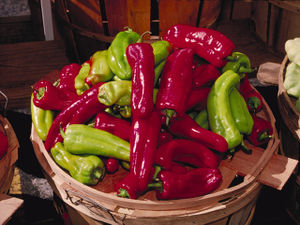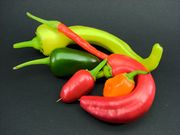Capsicum
| Capsicum | |
|---|---|
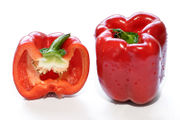 |
|
| Fruit and longitudinal section | |
| Scientific classification | |
| Kingdom: | Plantae |
| (unranked): | Angiosperms |
| (unranked): | Eudicots |
| (unranked): | Asterids |
| Order: | Solanales |
| Family: | Solanaceae |
| Subfamily: | Solanoideae |
| Tribe: | Capsiceae |
| Genus: | Capsicum L.[1] |
| Species | |
|
Capsicum annuum |
|
- For the fruit, see: Chili pepper
Capsicum is a genus of flowering plants in the nightshade family, Solanaceae. Its species are native to the Americas, where they have been cultivated for thousands of years by the people of the tropical Americas, and are now cultivated worldwide. Some of the members of Capsicum are used as spices, vegetables, and medicines. The fruit of Capsicum plants have a variety of names depending on place and type. They are commonly called chilli pepper, red or green pepper, or sweet pepper in Britain, and typically just capsicum in Australia, New Zealand, and Indian English. The large mild form is called bell pepper in the U.S. and Canada. They are called paprika in some other countries (although paprika can also refer to the powdered spice made from various capsicum fruit). The generic name is derived from the Greek word καπτο (kapto), meaning "to bite" or "to swallow."[3]
The original Mexican term, chilli (now chile in Mexico) came from the Nahuatl word chilli or xilli, referring to a larger Capsicum variety cultivated at least since 3000 BC, as evidenced by remains found in pottery from Puebla and Oaxaca.[4]
Contents |
Capsaicin in capsicum
The fruit of most species of Capsicum contains capsaicin (methyl vanillyl nonenamide), a lipophilic chemical that can produce a strong burning sensation in the mouth of the unaccustomed eater. Most mammals find this unpleasant, whereas birds are unaffected.[5][6] The secretion of capsaicin protects the fruit from consumption by mammals while the bright colors attract birds that will disperse the seeds.
Capsaicin is present in large quantities in the placental tissue (which holds the seeds), the internal membranes and, to a lesser extent, the other fleshy parts of the fruits of plants in the genus Capsicum. Contrary to popular belief, the seeds themselves do not produce any capsaicin, although the highest concentration of capsaicin can be found in the white pith around the seeds.[7]
The amount of capsaicin in Capsicums is highly variable and dependent on genetics, giving almost all types of Capsicums varied amounts of perceived heat. The only Capsicum without capsaicin is the bell pepper,[8] a cultivar of Capsicum annuum, which has a zero rating on the Scoville scale. The lack of capsaicin in bell peppers is due to a recessive gene that eliminates capsaicin and, consequently, the "hot" taste usually associated with the rest of the Capsicum family.[9]
Chili peppers are of great importance in Native American medicine, and capsaicin is used in modern medicine—mainly in topical medications—as a circulatory stimulant and analgesic. In more recent times, an aerosol extract of capsaicin, usually known as capsicum or pepper spray, has become widely used by police forces as a non-lethal means of incapacitating a person, and in a more widely dispersed form for riot control, or by individuals for personal defence.
Although black pepper and Sichuan pepper cause similar burning sensations, they are caused by different substances—piperine and hydroxy-alpha sanshool, respectively.
Cuisine
Capsicum fruits and peppers can be eaten raw or cooked. Those used in cooking are generally varieties of the C. annuum and C. frutescens species, though a few others are used as well. They are suitable for stuffing with fillings such as cheese, meat or rice.
They are also frequently used both chopped and raw in salads, or cooked in stir-fries or other mixed dishes. They can be sliced into strips and fried, roasted whole or in pieces, or chopped and incorporated into salsas or other sauces.
They can be preserved in the form of a jam[10], or by drying, pickling or freezing. Dried peppers may be reconstituted whole, or processed into flakes or powders. Pickled or marinated peppers are frequently added to sandwiches or salads. Frozen peppers are used in stews, soups, and salsas. Extracts can be made and incorporated into hot sauces.
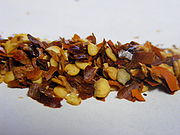
According to Richard Pankhurst, C. frutescens (known as barbaré) was so important to the national cuisine of Ethiopia, at least as early as the 19th century, "that it was cultivated extensively in the warmer areas wherever the soil was suitable." Although it was grown in every province, barbaré was especially extensive in Yejju, "which supplied much of Showa as well as other neighboring provinces." He singles out the upper Golima river valley as being almost entirely devoted to the cultivation of this plant, where thousands of acres were devoted to the plant and it was harvested year round.[11]
In 2005, a poll of 2,000 people revealed the capsicum pepper to be Britain's 4th favourite culinary vegetable.[12]
In Bulgaria, South Serbia and Macedonia, peppers are very popular, too. They can be eaten in salads, like Shopska Salata; fried and then covered with a dip of tomato paste, onions, garlic, and parsley; or stuffed with a variety of products—like minced meat and rice, beans, or cottage cheese and eggs. Peppers are also the main ingredient in the traditional tomato and pepper dip—lyutenitsa and ajvar. They are in the base of different kinds of pickled vegetables dishes—turshiya.
Peppers are also used widely in the Italian cuisine and the hot version is used all around the southern part of Italy as a common spice (sometimes it is served mixed with olive oil). Capsicum pepper is used in many dishes; it can be cooked itself in a variety of ways (roasted, fried, deepfried) and it is a fundamental ingredient for some delicattessen specialities, like Nduja.
Capsicums are also used extensively in Sri Lankan cuisine as side dishes.
Alternative Uses
For some years now, capsicum has been modified and used for other means, other eating, such as Dieting. However, this should be discussed with your family doctor, since it depends a lot on your body's condition, on how well you take spice and hot sauces, blood pressure and cholesterol levels.[13]
Species and varieties
Capsicum consists of approximately 20–27 species,[14] five of which are domesticated: C. annuum, C. baccatum, C. chinense, C. frutescens, and C. pubescens .[15] Phylogenetic relationships between species were investigated using biogeographical,[16] morphological,[17] chemosystematic,[18] hybridization,[19] and genetic[14] data. Fruits of Capsicum can vary tremendously in color, shape, and size both between and within species, which has led to confusion over the relationships between taxa.[20] Chemosystematic studies helped distinguish the difference between varieties and species. For example, C. baccatum var. baccatum had the same flavonoids as C. baccatum var. pendulum, which led researchers to believe that the two groups belonged to the same species.[18]
Many varieties of the same species can be used in many different ways; for example, C. annuum includes the "bell pepper" variety, which is sold in both its immature green state and its red, yellow or orange ripe state. This same species has other varieties as well, such as the Anaheim chiles often used for stuffing, the dried ancho chile used to make chili powder, the mild-to-hot jalapeño, and the smoked, ripe jalapeño, known as a chipotle.
Most of the capsaicin in a pungent (hot) pepper is concentrated in blisters on the epidermis of the interior ribs (septa) that divide the chambers of the fruit to which the seeds are attached.[21] A study on capsaicin production in fruits of C. chinense showed that capsaicinoids are produced only in the epidermal cells of the interlocular septa of pungent fruits, that blister formation only occurs as a result of capsaicinoid accumulation, and that pungency and blister formation are controlled by a single locus, Pun1, for which there exist at least two recessive alleles that result in non-pungency of C. chinense fruits.[22]
The amount of capsaicin in hot peppers varies significantly between varieties, and is measured in Scoville heat units (SHU). The world's current hottest known pepper as rated in SHU is the Bhut Jolokia pepper, which has been measured at 923,000 SHU.[23]
Species list
|
|
|
|
Formerly placed here
- Tubocapsicum anomalum (Franch. & Sav.) Makino (as C. anomalum Franch. & Sav.)
- Vassobia fasciculata (Miers) Hunz. (as C. grandiflorum Kuntze)
- Witheringia stramoniifolia Kunth (as C. stramoniifolium (Kunth) Kuntze)[2]
Synonyms and common names
The name given to the Capsicum fruits varies between English-speaking countries.
In Australia, New Zealand and India, heatless species are called "capsicums" while hot ones are called "chilli/chillies" (double L). Pepperoncini are also known as "sweet capsicum". The term "bell peppers" is almost never used, although C. annuum and other varieties which have a bell-shape and are fairly hot, are often called "bell chillies".
In the United Kingdom and Ireland, the heatless varieties are called "bell peppers", "sweet peppers" or "peppers" (or "green peppers," "red peppers," etc.) while the hot ones are "chilli/chillies" (double L) or "chilli peppers".
In the United States and Canada, the common heatless species is referred to as "bell peppers," "sweet peppers," "red/green/etc peppers," or simply "peppers", while the hot species are collectively called "chile/chiles," "chili/chilies," or "chili/chile peppers" (one L only), "hot peppers", or named as a specific variety (e.g., banana pepper).
The name "pepper" came into use because the plants were hot in the same sense as the condiment black pepper, Piper nigrum. But there is no botanical relationship with this plant, nor with Sichuan pepper.
In Polish and in Hungarian, the term "papryka" and "paprika" (respectively) is used for all kinds of capsicum peppers (the sweet vegetable, and the hot spicy) as well as for dried and ground spice made from them (named paprika in both US English and Commonwealth English). Also fruit and spice can be attributed as "papryka ostra" (hot pepper) or "papryka słodka" (sweet pepper). The term "pieprz" (pepper) instead means only grained or ground black pepper (incl. its green, white, and red forms) but not capsicum. Sometimes the hot capsicum spice is also called "chilli".
In Italy and the Italian- and German-speaking parts of Switzerland, the sweet varieties are called "peperone" and the hot varieties "peperoncino" (literally "small pepper"). In French, capsicum is called "poivron". In German, capsicum is called "paprika"; in Dutch, this word is used for bell peppers, whereas "chilli" is reserved for powders and hot pepper variants are referred to as "Spaanse pepers" (Spanish peppers). In Switzerland however, the condiment powder made from capsicum is called "paprika" (German language regions) and "paprica" (French and Italian language region).
In Spanish-speaking countries there are many different names for each variety and preparation. In Mexico the term chile is used for "hot peppers" while the heatless varieties are called pimiento (the masculine form of the word for pepper, which is pimienta). Several other countries, such as Chile, whose name is unrelated, Perú, Puerto Rico, and Argentina, use ají. In Spain, heatless varieties are called pimiento and hot varieties guindilla. Also, in Argentina and Spain, the variety C. chacoense is commonly known as "putaparió", a slang expression equivalent to "God damn it", probably due to its highly hot flavour. In Indian English, the word "capsicum" is used exclusively for Capsicum annuum. All other varieties of hot capsicum are called chilli. In northern India and Pakistan, Capsicum annuum is also commonly called "Shimla Mirch" in the native languages. Shimla incidentally is a popular hill-station in India (and "Mirch" means chilli in local languages).
In Japanese, tōgarashi (唐辛子, トウガラシ "Chinese mustard") refers to hot chili peppers, and particularly a spicy powder made from them which is used as a condiment, while bell peppers are called pīman (ピーマン, from the French piment or the Spanish pimiento).
Pictures of capsicum cultivars
|
Capsicum annuum cultivars |
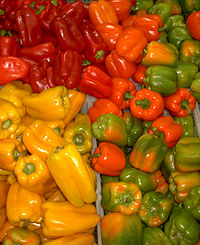 A variety of coloured Capsicum |
 Peperoncini (C. annuum) |
 Peperoncini in kebab restaurant |
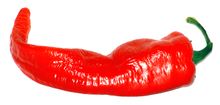 Cayenne pepper (C. annuum) |
 Compact plant of orange Capsicum |
.jpg) Habanero chili (C. chinense Jacquin)- plant with flower and fruit |
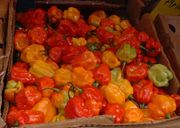 Scotch bonnet (C. chinense) in a Caribbean market |
 Scotch bonnet (C. chinense) |
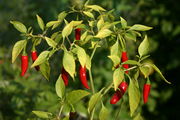 Thai peppers (C. Frutescens) |
 Fresh Indian Green chillies in Bangalore market |
 Piri piri (C. frutescens 'African Devil') |
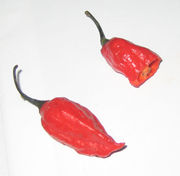 Naga Jolokia pepper aka Bhut Jolokia (C. chinense x C. frutescens) |
Capsicum annuum flower |
Capsicum annum flower close up |
 Green, yellow and red peppers |
See also
- Scoville scale
- Pimento
References
- ↑ "Capiscum L.". Germplasm Resources Information Network. United States Department of Agriculture. 2009-09-01. http://www.ars-grin.gov/cgi-bin/npgs/html/genus.pl?2056. Retrieved 2010-02-01.
- ↑ 2.0 2.1 2.2 "Species records of Capiscum". Germplasm Resources Information Network. United States Department of Agriculture. http://www.ars-grin.gov/cgi-bin/npgs/html/splist.pl?2056. Retrieved 2010-06-23.
- ↑ Quattrocchi, Umberto (2000). CRC World Dictionary of Plant Names. 1 A-C. CRC Press. p. 431. ISBN 9780849326752. http://books.google.com/?id=esMPU5DHEGgC.
- ↑ Gil-Jurado, A. T., Il senso del chile e del piccante: dalla traduzione culturale alla rappresentazione visiva in (G. Manetti, ed.), Semiofood: Communication and Culture of Meal, Centro Scientifico Editore, Torino, Italy, 2006:34–58
- ↑ Mason, J. R.; N. J. Bean; P. S. Shah; L. Clark Shah (December 1991). "Taxon-specific differences in responsiveness to capsaicin and several analogues: Correlates between chemical structure and behavioral aversiveness". Journal of Chemical Ecology 17 (12): 2539–2551. doi:10.1007/BF00994601. http://www.springerlink.com/content/w05ux25g162366x1/.
- ↑ Norman, D. M.; J. R. Mason; L. Clark (1992). "Capsaicin effects on consumption of food by Cedar Waxwings and House Finches". The Wilson Journal of Ornithology 104: 549–551.
- ↑ New Mexico State University – College of Agriculture and Home Economics (2005). "Chile Information - Frequently Asked Questions". http://spectre.nmsu.edu/dept/academic.html?i=1274&s=sub. Retrieved May 17, 2007.
- ↑ http://www.chiliwonders.com/chili.scoville.htm
- ↑ "The World's Healthies Foods". http://whfoods.com/genpage.php?tname=foodspice&dbid=50. Retrieved February 23, 2010.
- ↑ http://www.askgarden.com/when-life-gives-you-peppers-use-this-pepper-jam-recipe/
- ↑ Pankhurst, Richard (1968). Economic History of Ethiopia. Addis Ababa: Haile Selassie I University Press. pp. 193–194.
- ↑ Wainwright, Martin (2005-05-23). "Onions come top for British palates". The Guardian (London). http://www.guardian.co.uk/britain/article/0,2763,1489887,00.html. Retrieved 2007-10-30.
- ↑ Capsicum & CapsiPure & CapsiPlex
- ↑ 14.0 14.1 Walsh, B.M.; Hoot, S.B. (2001). "Phylogenetic Relationships of Capsicum (Solanaceae) Using DNA Sequences from Two Noncoding Regions: The Chloroplast atpB-rbcL Spacer Region and Nuclear waxy Introns" (– Scholar search). International Journal of Plant Sciences 162 (6): 1409–1418. doi:10.1086/323273. http://www.journals.uchicago.edu/IJPS/journal/issues/v162n6/010108/010108.text.html. Retrieved 2007-12-20.
- ↑ Heiser Jr, C.B.; Pickersgill, B. (1969). "Names for the Cultivated Capsicum Species (Solanaceae)". Taxon (Taxon, Vol. 18, No. 3) 18 (3): 277–283. doi:10.2307/1218828. http://links.jstor.org/sici?sici=0040-0262(196906)18%3A3%3C277%3ANFTCCS%3E2.0.CO%3B2-L. Retrieved 2007-12-20.
- ↑ Tewksbury, J.J.; Manchego, C.; Haak, D.C.; Levey, D.J. (2006). "Where did the Chili Get its Spice? Biogeography of Capsaicinoid Production in Ancestral Wild Chili Species". Journal of Chemical Ecology 32 (3): 547–564. doi:10.1007/s10886-005-9017-4. PMID 16572297. http://www.springerlink.com/index/WW8646806H541112.pdf. Retrieved 2007-12-20.
- ↑ Eshbaugh, W.H. (1970). "A Biosystematic and Evolutionary Study of Capsicum baccatum (Solanaceae)". Brittonia (Brittonia, Vol. 22, No. 1) 22 (1): 31–43. doi:10.2307/2805720. http://links.jstor.org/sici?sici=0007-196X(197001%2F03)22%3A1%3C31%3AABAESO%3E2.0.CO%3B2-K. Retrieved 2007-12-20.
- ↑ 18.0 18.1 Ballard, R.E.; McClure, J.W.; Eshbaugh, W.H.; Wilson, K.G. (1970). "A Chemosystematic Study of Selected Taxa of Capsicum". American Journal of Botany (American Journal of Botany, Vol. 57, No. 2) 57 (2): 225–233. doi:10.2307/2440517. http://links.jstor.org/sici?sici=0002-9122(197002)57:2%3C225:ACSOST%3E2.0.CO;2-I. Retrieved 2007-12-20.
- ↑ Pickersgill, B. (1971). "Relationships Between Weedy and Cultivated Forms in Some Species of Chili Peppers (Genus capsicum)". Evolution (Evolution, Vol. 25, No. 4) 25 (4): 683–691. doi:10.2307/2406949. http://links.jstor.org/sici?sici=0014-3820(197112)25%3A4%3C683%3ARBWACF%3E2.0.CO%3B2-H. Retrieved 2007-12-20.
- ↑ Eshbaugh, W.H. (1975). "Genetic and Biochemical Systematic Studies of Chili Peppers (Capsicum-Solanaceae)". Bulletin of the Torrey Botanical Club (Bulletin of the Torrey Botanical Club, Vol. 102, No. 6) 102 (6): 396–403. doi:10.2307/2484766. http://links.jstor.org/sici?sici=0040-9618(197511%2F12)102%3A6%3C396%3AGABSSO%3E2.0.CO%3B2-9. Retrieved 2007-12-20.
- ↑ Zamski, E.; Shoham, O.; Palevitch, D.; Levy, A. (1987). "Ultrastructure of Capsaicinoid-Secreting Cells in Pungent and Nonpungent Red Pepper (Capsicum annuum L.) Cultivars". Botanical Gazette 148 (1): 1–6. doi:10.1086/337620. http://links.jstor.org/sici?sici=0006-8071(198703)148%3A1%3C1%3AUOCCIP%3E2.0.CO%3B2-S. Retrieved 2007-12-20.
- ↑ Stewart Jr, C.; Mazourek, M.; Stellari, G.M.; O'Connell, M.; Jahn, M. (2007). "Genetic control of pungency in C. chinense via the Pun1 locus". Journal of Experimental Botany 58 (5): 979. doi:10.1093/jxb/erl243. PMID 17339653.
- ↑ Simon de Bruxelles (1 April, 2006). "The chilli so hot you need gloves". London: Times Newspapers Ltd.. http://www.timesonline.co.uk/tol/news/uk/article700700.ece. Retrieved 4 November, 2009.
External links
- Capsicum pepper factsheet from Purdue Guide to Medicinal and Aromatic Plants
- Capsicums: Innovative Uses of an Ancient Crop History, Botany, Breeding, and Pungency. Purdue University, Indiana, U.S.A.
- IBPGR (1985). Solanacaea. International Board for Plant Genetic Resources, Rome, Italy. http://www.bioversityinternational.org/publications/Web_version/52/ch52.htm.
- Descriptors for Capsicum (Capsicum spp.) fom Bioversity International (PDF, 770 kb)
- Capsicum and Chillies: Commercial Cultivation DPI&F Queensland, Australia.
|
|||||||||||||||||
|
||||||||||||||||||||||||||||||||||||||||||
